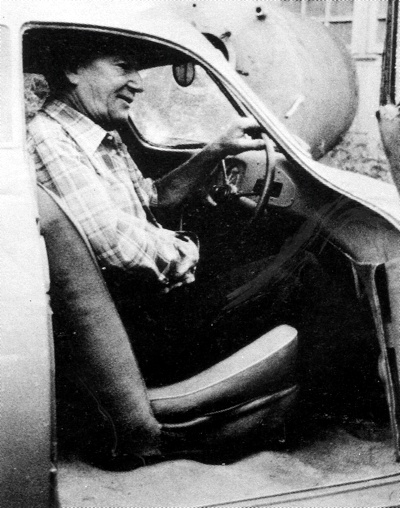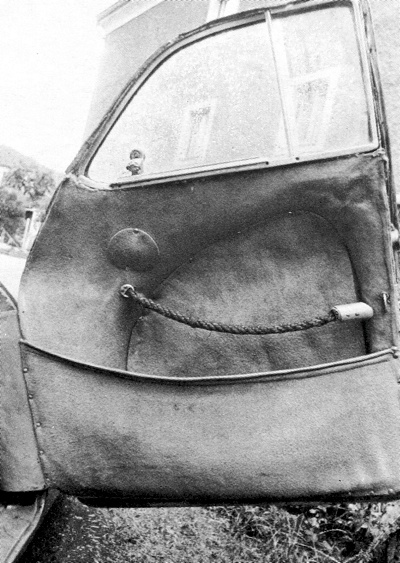Porsche 64
Reviewed by Unique Cars and Parts
Our Rating: 5
Introduction
Why call it the Type 64? The model number came about because the car was built mainly from design drawings for the Type-64 "record car". Most mechanical parts came from the 38 prototype series. The chassis was heavily reinforced and the engine also reworked to produce around 100 horse power. The Type-64 was only a drawing until the three racing cars were built. The body was also a compromise in that the cab had to look like a KdF car, but the rest was 'record' car. The VW beetle was the Type-60, and the name the "60K10" means body design 10 for the Type-60 Beetle. Its flat-four engine produced 50 bhp and gave a top speed of around 160 km/h (99 mph).
The Berlin-Rome Volkswagen
As mentioned above, today we know it as the Porsche 64, Type 64 or Type 60K10. But in its day, the slope-shouldered streamliner was more often than not referred to as the "Berlin-Rome Volkswagen". Strange, when you consider the car never ran in any event of that name for the very good reason that Europe was absorbed in other matters by September 1939. The grandiose capital-to-capital race was never held. It was to be, in reality, not a Porsche but the first VW special � but built in Porsche's own Zuffenhausen shops. After the war Porsche decided to modify the design to create the
356, rather than have
Volkswagen build the car.
Professor Porsche was a man who seldom discarded a paradoxical passion, no matter how long it might take to realise the idea. For every popular sedan he designed there was apt to be a sporting spinoff hovering between his mind and drawing board. This held true from Austro Daimler to Ziindapp but such dual dreaming reached fullest flowering in his most famous offspring, that ultimate people-car called the
Volkswagen. Almost before Porsche was even sure he had solid Reich backing for the Beetle, he was trying to hard-sell state leaders like Ley of the Arbeitsfront on a sports car.
He reasoned that the plant going up near Fallersleben - in an area later called Wolfsburg - was programmed for up to 1.5 million cars each year so a second body style was only logical. Thus he sought funds for building a prototype sports version but Ley's office people couldn't quite see their treasured machine for the volk turned into an elite two-seater. Thank you, but no thank you. This left Porsche with redundant plans for Type 64 (beetle being number 60 on his list) sketched as early as 1937 - 1938 and based on an air-cooled flat four enlarged to 1.5 litres, then clothed in aluminium.
A Three-Nation Highway Trial Between Berlin and Rome
The Porsche design B�ro turned out some 63 designs of all kinds between 1935 and 1940 with nearly half of them (29) VW-oriented. They ranged from a hydro-mechanical gearbox to Roots or turbo supercharging, injection or even a column shift lever for a fully-synchronised manual box. Turned down by Ley, Porsche actually debated going into production on his own, a good 10 years before that finally happened, although the idea had been with him since at least 1922. The body design for the Type 64 was made by the Porsche B�ro after wind tunnel tests for a planned V10 sports car that never came into existence, the Type 114.
Dr. Porsche promoted the idea to enter the car into the 1939 Berlin-Rome race as a public relations ploy. Three cars were made in hand shaped aluminium by the bodywork company Reutter (one was destroyed early in World War II, the two remaining cars were used by the Porsche family).
 Walter Mathe pictured behind the wheel of his Type 64.
Walter Mathe pictured behind the wheel of his Type 64.
 Tissue-thin doors of the Type 64.
Tissue-thin doors of the Type 64.
 Spartan cockpit of Porsche Type 64.
Spartan cockpit of Porsche Type 64.
|
The question remained - could Porsche buy VW beetle bits which could then be assembled in more sporting manner at Zuffenhausen? Tha answer was No! That idea proved illegal under German law - government enterprises couldn't sell to private undertakings, not even to the designer of those same parts: Porsche apparently chose not to carry his argument to the very top. Or perhaps he did - in a more roundabout manner. There is no proof that Porsche furnished the push but he certainly wouldn't have objected when Huhnlein's office, which controlled all motor sport in Germany at the time, proposed a three-nation highway bash between Berlin and Rome. This audacious run would use flat-out autobahns to Munich, then normal closed roads across Austria, the Brenner Pass and halfway down Italy; a good 1300 km in all.
Built in Zuffenhausen
VW sedan deliveries had been very slow when this idea came up but the management hoped to have cars by September 1939 and agreed that entry in a race of such note that same month would be the perfect launch pad. Several firms rushed to streamline their best cars, just as
Porsche did. The VW's designers realised 19 kW (25 bhp) wouldn't be a winner in the usual 105 km/h body - but it was enough to start with. More importantly Ley's department was suddenly keen on the event - so funds were found for three VW specials built in Zuffenhausen and based on the shelved Type 64 although the proper designation for these works cars was 60K10: based on the model 60 Beetle with special bodywork (K = karosserie) of the tenth design.
Either time or inclination were lacking for the full mid-engined route Porsche preferred. He settled instead on near-middle seating for the driver, still based on the standard VW platform with 240 cm wheelbase and 128.4 cm track. Minimal frontal area led to near-monoposto cabin accommodation although there was provision for a lightweight co-driver bucket set back by some 30 cm. Reutter, across the street from Porsche's shops, built the bodies to a Komenda design. This recalled the visionary Type 114 V10 but was simultaneously more extreme around the turret, yet graced by as many production-car touches as possible: nose panel trim, rear louvres and window shapes, for instance, to maintain public identification with those beetles everybody was supposed to be saving for.
The cars were not only very slim and voluptuously curved but also panelled in aluminium so thin (0.5 mm) you could slam a door and crack the B-pillar. A large fuel tank and two spares went into the nose, a battery was placed behind the driver and both sets of wheels were covered with spats. Nor was the engine entirely neglected although we run into discrepancies in the definitive specifications here. A stock VW engine then displaced 985 cm3, and the big 1131 cm3 version for cross-country army cars would only appear officially in 1940. But Porsche had certainly thought of larger capacities before the Berlin-Rome trio was built.
In any case they enlarged valves, raised compression to (apparently) 7.5:1 (from 5.8) and - a key feature ignored in the official VW spec sheet - used not one but two of the Solex 26 carbs. That is really the only way to improve performance from a flat four. Of course their ace was the engine's ability to run all day at peak revs - the power (variously quoted as 24 or 30 kW/32 or 40 bhp) came at 3800-4000 rpm, compared to a rev peak of 3000 for the original Beetle. As nearly as can be told from that sole survivor, the racer used a VW gearbox with 0.80 top gear and also-normal 4.43:1 final drive. But it only weighed some 545 kg complete against 755 kg for the first post-war, 985 cm3 civilian
Beetle.
The tweaks were ample to make the racer faster than a Beetle's 105 km/h - up to anything from 140 to over 160 has been claimed at various times. Since there was no 1939 race to time we can only note that Porsche and his chauffeur once did Fallersleben to Berlin at an average of 140, including towns. Ferdinand often used the car as a sort of early executive jet. A second went to Dr Lafferentz, a Ley deputy, and was probably written off in a crash, not bombed by the Allies as sometimes claimed. The third was used by Welin, a Munich car dealer and advisor to Hitler. It was probably the one liberated by Americans from Zell am See (Austria), cut down to a cabriolet, and run until its oil-less engine quit, at which point it was scrapped.
Restoration by Battista Farina
The last remaining Porsche 64 was owned by Ferry Porsche who had it restored by Battista Farina in 1947. In 1949 it was sold to the (Innsbruck) Austrian motorcycle racer Otto Math� and with it he won the Alpine Rally in
1950.
One of the three cars had a slimmer windscreen and side window frames with wiper pivots moved to the bottom of the glass and trafficator flippers covered over. Most surviving photos show Porsche's own car in this form, plus cloth covers over the lamps for blackout driving. It matches the sole survivor obtained from Prof. Porsche in the late 1940s by Otto Mathe. In 1950-51 he raced it as a new sports car then tucked it into his spacious barn where it languished until a classic car meet late in
1977. The last time he drove it in a race was at the Monterey Historic Races in Monterey, California, in
1982.
Mathe converted his Porsche Type 64 to right-hand drive and fitted it with hydraulic (replacing the cable brakes). He spoke with considerable pride to motoring journalists when he was in Monterey, remembering the old Professor telling him, "Mathe you did a good job on those brakes". The right-hand seating was necessary because Mathe lost all use of his right arm in a speedway bike crash during 1934. That came eight years after he was Austrian pushbike mountain champ on a bicycle he built himself, then a winning motorcycle racer, road and oval, but before he became a successful sidecar racer with one useable arm.
Mathe switched to car racing after the war, took three Austrian sports car titles, beat works Porsches with a Spyder he designed himself and owned the local ice-racing scene in a Porsche-powered monoposto which introduced a heads-up tach out on the nose for quick reading. He also invented windscreen washers by fitting two tubes, a thermos bottle reservoir and foot pedal to one of his early-356 alloy coupes. Along the way Mathe tested his own all-fuels rotary engine two years before the Wankel was revealed, concocted an oil additive which was sold world-wide, created the first buckle ski-boots (in 1935) to avoid one-hand lacing and patented an early safety binding for skis. Despite all this diversity he never raced any four-wheeler without Porsche power of some sort.
That streak included overall victory in Austria's 1951 Alpine Trial with the Berlin-Rome car. He used the one-litre machine for everything from hillclimb sprints to long-distance rallies and won most times.



